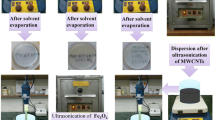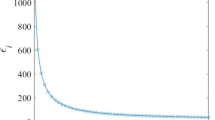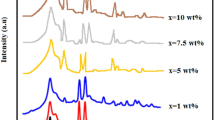Abstract
The dielectric properties of polymer nanocomposites (PNCs) are crucial in designing electronic packaging, energy storage capacitors, electromagnetic shielding, and biomedical sensors and actuators. The conventional mixing rules-based methods such as the Kerner model, Maxwell–Garnett (MG) model, Maxwell–Wagner-Sillars (MWS) model, Bruggeman model solely rely on the volume fraction (vol%), which is often inadequate to predict the frequency dependency of the effective permittivity of the PNCs, they also do not account for the sizes of the inclusions. A computational model was developed to estimate the dielectric permittivity and the dielectric loss of PNCs using COMSOL multi-physics. Experimental data from previously published references confirmed the validity of the finite element analysis (FEA) based model. Next, the COMSOL model was utilized to quantitatively analyze the complex dielectric constant as a function of the applied frequency, the dielectric properties of the inclusion and the polymer matrix, and the volume fraction of the inclusion. The study was conducted with a polymer matrix of polymethylmethacrylate (PMMA) and five nanoparticles including semiconductor material silicon (Si), inorganic zinc-sulfide (ZnS), metal gold (Au), metal-oxide titanium oxide (TiO2), and dielectric fillers BaTiO3 (BT). The results show that the frequency-dependent dielectric relaxation behavior, the MWS interfacial polarization, significantly influences the dielectric properties. A 10 vol% inclusion of Si, ZnS, and BT resulted in MWS frequency of 103, 1584, 105 Hz. The charge barrier is most substantial in low frequency as it restricts electric field propagation around the inclusion. However, at a significantly high frequency, the charge barrier breaks, lowering the dielectric constant of the composite. In addition to that, a unique behavior was observed in high conductive fillers PNCs (e.g., Au) as the permittivity showed a fillers size dependence even with the same volume fraction. At frequency nearing 105 Hz, the Au-PMMA composite showed a higher permittivity with smaller nanoparticles inclusion. This is a significant finding contrary to the existing understandings based on the conventional mixing rules (e.g., MWS, MG, Bruggeman, Kerner model), which does not account for the size of inclusions. The present study has important implications for device engineers and materials manufacturers to choose appropriate materials with desired properties for optoelectronic packaging applications.








Similar content being viewed by others
Data Availability
The datasets are available from the corresponding author on reasonable request.
References
Masoud, E.M.: Montmorillonite incorporated polymethylmethacrylate matrix containing lithium trifluoromethanesulphonate (LTF) salt: thermally stable polymer nanocomposite electrolyte for lithium-ion batteries application. Ionics. 25, 2645–2656 (2019)
Masoud, E.M., El-Bellihi, A.A., Bayoumy, W.A., et al.: Polymer composite containing nano magnesium oxide filler and lithiumtriflate salt: An efficient polymer electrolyte for lithium ion batteries application. J. Mol. Liq. 260, 237–244 (2018)
Masoud, E.M., Hassan, M.E., Wahdaan, S.E., et al.: Gel P (VdF/HFP) / PVAc / lithium hexafluorophosphate composite electrolyte containing nano ZnO filler for lithium ion batteries application: Effect of nano filler concentration on structure thermal stability and transport properties. Polym. Test. 56, 277–286 (2016)
Masoud, E.M.: Nano lithium aluminate filler incorporating gel lithium triflate polymer composite: Preparation, characterization and application as an electrolyte in lithium ion batteries. Polym. Test. 56, 65–73 (2016)
Chao, C.-G., Kumar, M.P., Riaz, N., et al.: Polyisobutylene Oligomers as Tools for Iron Oxide Nanoparticle Solubilization. Macromolecules. 50, 1494–1502 (2017)
Galland, S., Andersson, R.L., Ström, V., et al.: Strong and Moldable Cellulose Magnets with High Ferrite Nanoparticle Content. ACS. Appl. Mater. Interfaces. 6, 20524–20534 (2014)
Zhou, L., He, B., Huang, J.: One-Step Synthesis of Robust Amine- and Vinyl-Capped Magnetic Iron Oxide Nanoparticles for Polymer Grafting Dye Adsorption and Catalysis. ACS. Appl. Mater. Interfaces. 5, 8678–8685 (2013)
He, Q., Yuan, T., Zhang, X., et al.: Magnetically Soft and Hard Polypropylene/Cobalt Nanocomposites: Role of Maleic Anhydride Grafted Polypropylene. Macromolecules. 46, 2357–2368 (2013)
Zhang, X., He, Q., Gu, H., et al.: Flame-Retardant Electrical Conductive Nanopolymers Based on Bisphenol F Epoxy Resin Reinforced with Nano Polyanilines. ACS. Appl. Mater. Interfaces. 5, 898–910 (2013)
Islam, M.D., Liu, S., Boyd, D.A., et al.: Enhanced mid-wavelength infrared refractive index of organically modified chalcogenide (ORMOCHALC) polymer nanocomposites with thermomechanical stability. Opt. Mater. 108, 110197 (2020)
Kim, H., Miura, Y., MacOsko, C.W.: Graphene/polyurethane nanocomposites for improved gas barrier and electrical conductivity. Chem. Mater. 22, 3441–3450 (2010)
Yao, J., Liu, Z., Liu, Y., et al.: Optical Negative Refraction in Bulk Metamaterials of Nanowires. Science. 321, 930 (2008)
Zhu, J., Wei, S., Yadav, A., et al.: Rheological behaviors and electrical conductivity of epoxy resin nanocomposites suspended with in-situ stabilized carbon nanofibers. Polymer 51, 2643–2651 (2010)
Mavinakuli, P., Wei, S., Wang, Q., et al.: Polypyrrole/silicon carbide nanocomposites with tunable electrical conductivity. J. Phys. Chem. C. 114, 3874–3882 (2010)
Zhu, J., Wei, S., Ryu, J., et al.: In situ stabilized carbon nanofiber (CNF) reinforced epoxy nanocomposites. J. Mater. Chem. 20, 4937 (2010)
Guo, Z., Park, S., Hahn, H.T., et al.: Giant magnetoresistance behavior of an iron/carbonized polyurethane nanocomposite. Appl. Phys. Lett. 90 (2007). https://doi.org/10.1063/1.2435897. (Epub ahead of print)
Wang, L., Qiu, J.J., McMahon, W.J., et al.: Nano-oxide-layer insertion and specular effects in spin valves: Experiment and theory. Phys. Rev. B. 69, 214402 (2004)
Zhu, J., Wei, S., Alexander, M.J., et al.: Enhanced electrical switching and electrochromic properties of poly(p-phenylenebenzobisthiazole) thin films embedded with nano-WO3. Adv. Funct. Mater. 20, 3076–3084 (2010)
Zhu, J., Wei, S., Chen, X., et al.: Electrospun polyimide nanocomposite fibers reinforced with core-shell fe-feo nanoparticles. J. Phys. Chem. C. 114, 8844–8850 (2010)
Podsiadlo, P., Kaushik, A.K., Arruda, E.M., et al.: Ultrastrong and Stiff Layered Polymer Nanocomposites. Science. 318, 80–83 (2007)
Podsiadlo, P., Liu, Z., Paterson, D., et al.: Fusion of Seashell Nacre and Marine Bioadhesive Analogs: High-Strength Nanocomposite by Layer-by-Layer Assembly of Clay and L-3,4-Dihydroxyphenylalanine Polymer. Adv. Mater. 19, 949–955 (2007)
Chen, X., Wei, S., Gunesoglu, C., et al.: Electrospun Magnetic Fibrillar Polystyrene Nanocomposites Reinforced with Nickel Nanoparticles. Macromol. Chem. Phys. 211, 1775–1783 (2010)
Franzoso, F., Vaca-Garcia, C., Rouilly, A., et al.: Extruded versus solvent cast blends of poly(vinyl alcohol-co-ethylene) and biopolymers isolated from municipal biowaste. J. Appl. Polym. Sci. 133, 43009 (2016)
Cataldi, P., Bayer, I.S., Nanni, G., et al.: Effect of graphene nano-platelet morphology on the elastic modulus of soft and hard biopolymers. Carbon. N. Y. 109, 331–339 (2016)
Li, Y., Jia, S., Du, S., et al.: Improved properties of recycled polypropylene by introducing the long chain branched structure through reactive extrusion. Waste. Manag. 76, 172–179 (2018)
Miu, E.V., Fox, A.J., Jubb, S.H., et al.: Morphology and toughness enhancements in recycled high-density polyethylene (rHDPE) via solid-state shear pulverization (SSSP) and solid-state/melt extrusion (SSME). J. Appl. Polym. Sci. 133, 43070 (2016)
Masoud, E.M.: Citrated porous gel copolymer electrolyte composite for lithium ion batteries application: An investigation of ionic conduction in an optimized crystalline and porous structure. J. Alloys. Compd. 651, 157–163 (2015)
Masoud, E.M., El-Bellihi, A.A., Bayoumy, W.A., et al.: Effect of LiAlO2 nanoparticle filler concentration on the electrical properties of PEO-LiClO4 composite. Mater. Res. Bull. 48, 1148–1154 (2013)
Masoud, E.M., El-Bellihi, A.A., Bayoumy, W.A., et al.: Organic-inorganic composite polymer electrolyte based on PEO-LiClO 4 and nano-Al2O3 filler for lithium polymer batteries: Dielectric and transport properties. J. Alloys. Compd. 575, 223–228 (2013)
El Bellihi, A.A., Bayoumy, W.A., Masoud, E.M., et al.: Preparation, characterizations and conductivity of composite polymer electrolytes based on PEO-LiClO 4 and nano ZnO filler. Bull. Korean. Chem. Soc. 33, 2949–2954 (2012)
Venugopal, V.C., Lakhtakia, A., Messier, R., et al.: Low-permittivity nanocomposite materials using sculptured thin film technology. J. Vac. Sci. Technol. B. Microelectron. Nanom. Struct. Process. Meas. Phenom. 18, 32 (2000)
Mikrajuddin, Shi FG, Okuyama K, et al. Conduction development in electrically conductive adhesives with a bimodal size distributed conducting and inert particles: Effect of polydispersity. In: 2000 Proceedings. 50th Electronic Components and Technology Conference, pp. 609–614. IEEE (2000)
Mikrajuddin, Shi, F.G., Nieh, T.G., et al.: Electrical conduction in solid polymer electrolytes: temperature dependence mechanism. Microelectronics. J. 31, 261–265 (2000)
Mikrajuddin, M., Okuyama, K., Shi, F.G., et al.: Dielectric constant of polymer composites: A novel thermal-electrical approach. In: Conference Record of the 2000 IEEE International Symposium on Electrical Insulation, pp. 180–183. IEEE (2000)
Vo, H.T., Shi, F.G.: Towards model-based engineering of optoelectronic packaging materials: Dielectric constant modeling. Microelectronics. J. 33, 409–415 (2002)
Venugopal, V.C., Lakhtakia, A., Messier, R., et al.: Low-permittivity nanocomposite materials using sculptured thin film technology. J. Vac. Sci. Technol. B. Microelectron. Nanom. Struct. Process. .Meas Phenom. 18, 32 (2000)
Walpita, L.M., Ahern, M.R.: Temperature compensated high-dielectric-constant thermoplastic microwave materials. IEE. Proc. Microwaves. Antennas. Propag. 147, 285–288 (2000)
Jackson, M., Stern, C.: Modeling the Complex Permittivity of Thermoplastic Composite Materials. J. Microw. Power. Electromagn. Energy. 27, 103–111 (2016). https://doi.org/10.1080/08327823.1992.11688178
Rogti, F., Ferhat, M.: Maxwell-Wagner polarization and interfacial charge at the multi-layers of thermoplastic polymers. J. Electrostat. 72, 91–97 (2014)
Horiuchi, N., Nakamura, M., Nagai, A., et al.: Proton conduction related electrical dipole and space charge polarization in hydroxyapatite. J. Appl. Phys. 112, 074901 (2012)
Kao, K.C.: Dielectric Phenomena in Solids. Elsevier Inc., Amsterdam (2004)
Lu, X., Zhang, A., Dubrunfaut, O., et al. Numerical modeling and experimental characterization of the AC conductivity and dielectric properties of CNT/polymer nanocomposites. Compos. Sci. Technol. 194, 108150 (2020)
Zhong, S.L., Dang, Z.M., Zha, J.W.: Prediction on effective permittivity of 0–3 connectivity particle/polymer composites at low concentration with finite element method. IEEE. Trans. Dielectr. Electr. Insul. 25, 2122–2127 (2018)
Wang, Z., Keith-Nelson, J., Hillborg, H., et al.: Dielectric constant and breakdown strength of polymer composites with high aspect ratio fillers studied by finite element models. Compos. Sci. Technol. 76, 29–36 (2013)
Simoes, R., Silva, J., Vaia, R., et al.: Low percolation transitions in carbon nanotube networks dispersed in a polymer matrix:dielectric properties simulations and experiments. Nanotechnology. 20, 035703 (2008)
Gupta, A., Hartner, S., Wiggers, H.: Optical and electrical properties of silicon nanoparticles. In: INEC 2010 - 2010 3rd Int Nanoelectron Conf Proc, pp. 616–617. IEEE (2010)
El-Barry, A.M.A., Atyia, H.E.: Dielectric relaxation and AC conductivity of XS (X=Cd, Zn) compounds. Phys. B. Condens. Matter. 368, 1–7 (2005)
Orfanidis, S.J.: Electromagnetic Waves and Antennas. Rutgers University, Piscataway, NJ. http://eceweb1.rutgers.edu/~orfanidi/ewa/ (2016). Accessed 20 July 2021
AZO Materials. Properties: Titanium Dioxide - Titania (TiO2). https://www.azom.com/properties.aspx?ArticleID=1179 (2002) Accessed 20 July 2021
Hao, Y., Wang, X., Bi, K., et al.: Significantly enhanced energy storage performance promoted by ultimate sized ferroelectric BaTiO3 fillers in nanocomposite films. Nano Energy 31, 49–56 (2017)
Shameer, A.B., Nandaprakash, M.B., Namratha, K., et al. Structure and Electrical Conductivity of Irradiated BaTiO3 Nanoparticles. Phys. Status. Solidi. Basic. Res. 255 (2018). https://doi.org/10.1002/PSSB.201700581. (Epub ahead of print)
Norris, A.N., Sheng, P., Callegari, A.J.: Effective-medium theories for two-phase dielectric media. J. Appl. Phys. 57, 1990 (1998)
Cheng, Y., Chen, X., Wu, K.: Modeling and simulation for effective permittivity of two-phase disordered composites. J. Appl. Phys. 103, 34111 (2008)
Chen, Z., Li, H., Xie, G., et al.: Core–shell structured Ag@C nanocables for flexible ferroelectric polymer nanodielectric materials with low percolation threshold and excellent dielectric properties. RSC. Adv. 8, 1–9 (2017)
Liu, G., Chen, Y., Gong, M., et al.: Enhanced dielectric performance of PDMS-based three-phase percolative nanocomposite films incorporating a high dielectric constant ceramic and conductive multi-walled carbon nanotubes. J. Mater. Chem. C. 6, 10829–10837 (2018)
Nguyen, B.H., Zhuang, X., Rabczuk, T.: Numerical model for the characterization of Maxwell-Wagner relaxation in piezoelectric and flexoelectric composite material. Comput. Struct. 208, 75–91 (2018)
Samet, M., Levchenko, V., Boiteux, G., et al.: Electrode polarization vs. Maxwell-Wagner-Sillars interfacial polarization in dielectric spectra of materials: Characteristic frequencies and scaling laws. J. Chem. Phys. 142, 194703 (2015)
Da Silva, A.B., Arjmand, M., Sundararaj, U., et al.: Novel composites of copper nanowire/PVDF with superior dielectric properties. Polymer 55, 226–234 (2014)
Song, S., Zheng, Z., Bi, Y., et al.: Improving the electroactive phase, thermal and dielectric properties of PVDF/graphene oxide composites by using methyl methacrylate-co-glycidyl methacrylate copolymers as compatibilizer. J. Mater. Sci. 54(5), 3832–3846 (2018)
Wang, Y., He, P., Li, F.: Preparation and dielectric property of MWCNT/CCTO/PVDF composite film. Mater. Res. Express. 5, 066304 (2018)
Roy, A.S., Gupta, S., Sindhu, S., et al.: Dielectric properties of novel PVA/ZnO hybrid nanocomposite films. Compos. Part. B. Eng. 47, 314–319 (2013)
Funding
J. Ryu was partly supported by the new faculty start-up fund at NCSU and was supported in part by the Air Force Research Laboratory RYDH Sensors Directorate, through the Air Force Office of Scientific Research Summer Faculty Fellowship Program®, Contract Numbers FA8750-15–3-6003 and FA9550-15–0001. The project was also partially supported by National Science Foundation under grant no. 2031558.
Author information
Authors and Affiliations
Corresponding author
Ethics declarations
Competing Interests
Authors are required to disclose financial or non-financial interests that are directly or indirectly related to the work submitted for publication. Please refer to “Competing Interests and Funding” below for more information on how to complete this section.
Additional information
Publisher's Note
Springer Nature remains neutral with regard to jurisdictional claims in published maps and institutional affiliations.
Rights and permissions
About this article
Cite this article
Islam, M.D., Liu, S., Choi, D. et al. Physics-based Computational Method Predicting the Dielectric Properties of Polymer Nanocomposites. Appl Compos Mater 29, 1579–1595 (2022). https://doi.org/10.1007/s10443-022-10026-3
Received:
Accepted:
Published:
Issue Date:
DOI: https://doi.org/10.1007/s10443-022-10026-3




